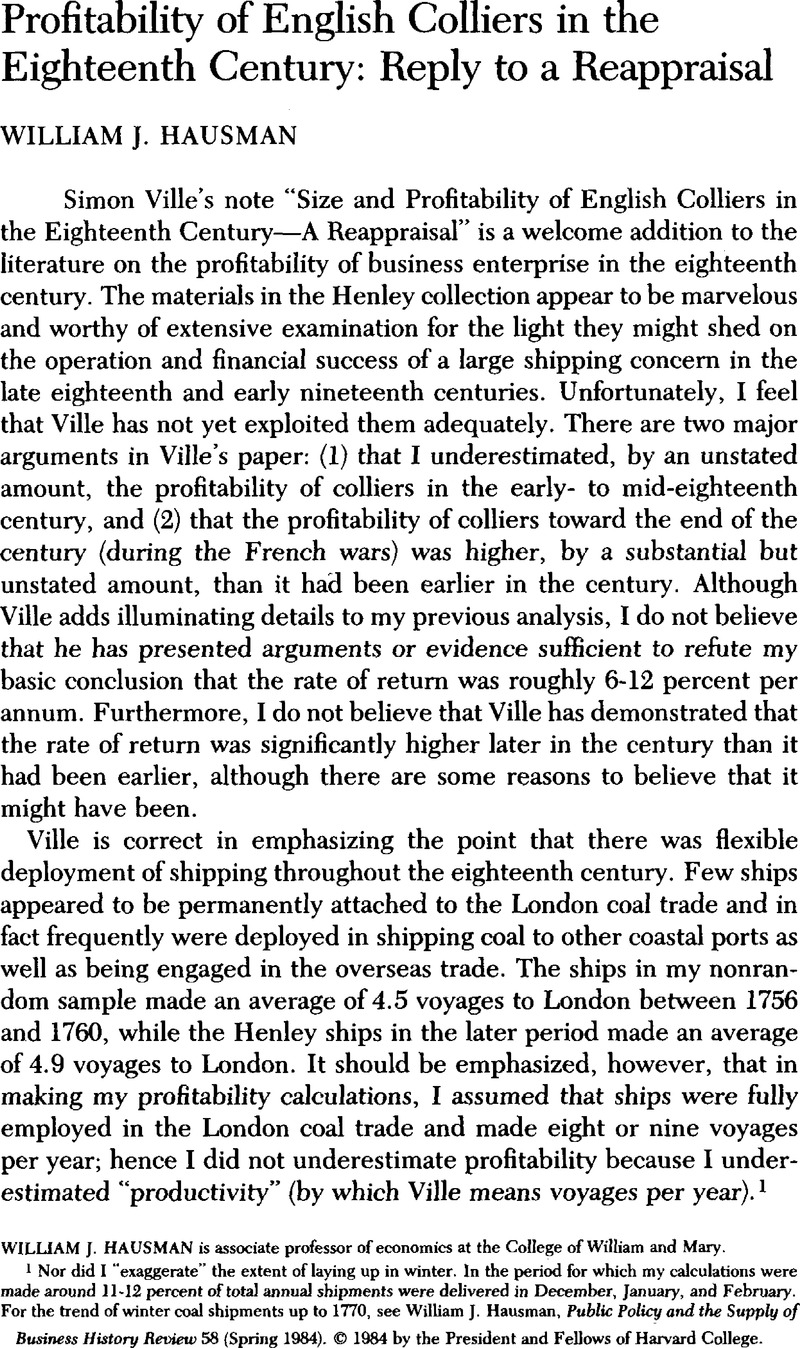No CrossRef data available.
Article contents
Profitability of English Colliers in the Eighteenth Century: Reply to a Reappraisal
Published online by Cambridge University Press: 11 June 2012
Abstract

- Type
- Reply
- Information
- Copyright
- Copyright © The President and Fellows of Harvard College 1984
References
1 Nor did I “exaggerate” the extent of laying up in winter. In the period for which my calculations were made around 11–12 percent of total annual shipments were delivered in December, January, and February. For the trend of winter coal shipments up to 1770, see Hausman, William J., Public Policy and the Supply of Coal to London, 1700–1770 (New York, 1981), 226.Google Scholar As the eighteenth century progressed winter shipments tended to increase somewhat. In 1799, 20 percent of total annual shipments were delivered in December through March. Report from the Committee Appointed to Consider the Coal Trade of this Kingdom, British Parliamentary Papers (BPP) 10 (1800): 628. When asked in 1800 what was the average number of voyages per year, Thomas Richmond, master of a collier answered, “Ships of about 220 tons measurement, will make from 8 to 11 voyages, larger ships not so many, frequently not above seven. I have myself commanded a large ship which never made more than seven voyages in the year.” Ibid., 562.
2 For a series of daily prices for the year 1799, see BPP 10 (1800): 582–87.
3 McCulloch, J. R., A Dictionary of Commerce (London, 1850), 1169.Google Scholar
4 Atack, Jeremy, Haites, Erik, Mak, James, and Walton, Gary, “The Profitability of Steamboating on Western Rivers: 1850,” Business History Review 49 (Autumn 1975): 348.Google Scholar The authors conclude that the rate of return on trunk lines averaged 8.5 percent, but that it was a “surprising” 24.1 percent on tributary routes. Ibid., 350. They also note the wide variability of profits among vessels.
5 The number of men borne by the navy rose from 17,000 in 1792 to 132,000 in 1801. Though this number subsequently declined briefly, the number of men rose to a peak of 147,000 in 1813. BPP 42 (1860): 547–49. Given the likely impact on the coal trade of the expansion of the number of men in the navy, it is truly remarkable that the real price of coal remained constant. Precisely how this was accomplished warrants further investigation.
6 An alternative way to view the problem is to note that the replacement cost of vessels (the denominator in profitability calculations) would have increased during the war, possibly by more than the general price level. When Thomas Gillespy, coal factor and ship owner, was asked in 1800 what was the prime cost of a collier, he answered, “It varies according to peace or war, and whether the ships are old or new. On an average, I think in peaceable times about £5 per ton; at present, £10.” BPP 10 (1800): 553.
7 That is, the variance of returns should be even greater than they were earlier in the century.
8 Ville does an excellent job of describing why Henley may have been able to capture these advantages.
9 A table indicating the number of ships owned in each year would have enhanced the presentation.
10 For a specific example of a related controversy see the exchange between Anderson, B. L. and Richardson, David, “Market Structure and Profits of the British African Trade in the Late Eighteenth Century: A Comment,” Journal of Economic History 43 (September 1983): 713–21CrossRefGoogle Scholar, and Inikori, J. E., “Market Structure and the Profits of the British African Trade in the Late Eighteenth Century: A Rejoinder,” Journal of Economic History 43 (September 1983): 723–28.CrossRefGoogle ScholarAnderson and Richardson found that William Davenport's seventy-four voyages between 1757 and 1784 earned an annual average return of 8 percent, while Inikori found that the twenty-four voyages of several large firms attained an average return of 27 percent.




